ZZ plants, also known by their botanical name Zamioculcas zamiifolia, have become increasingly popular due to their stunning appearance, no-fuss care routine, and remarkable ability to flourish even in the darkest corners of your home.
But here’s the secret to keeping your ZZ plant happy and thriving: it’s all about finding the perfect soil match!
In this comprehensive guide, we’ll explore the characteristics of the best soil for ZZ plants, various potting mix options, repotting practices, and common mistakes to avoid.
Characteristics of the Best Soil for ZZ Plants
Your ZZ plant deserves the best, and that starts with finding the perfect soil. To keep your ZZ plant healthy and happy, let’s explore the important qualities that make up the ideal soil for these beautiful plants.
Well-Draining
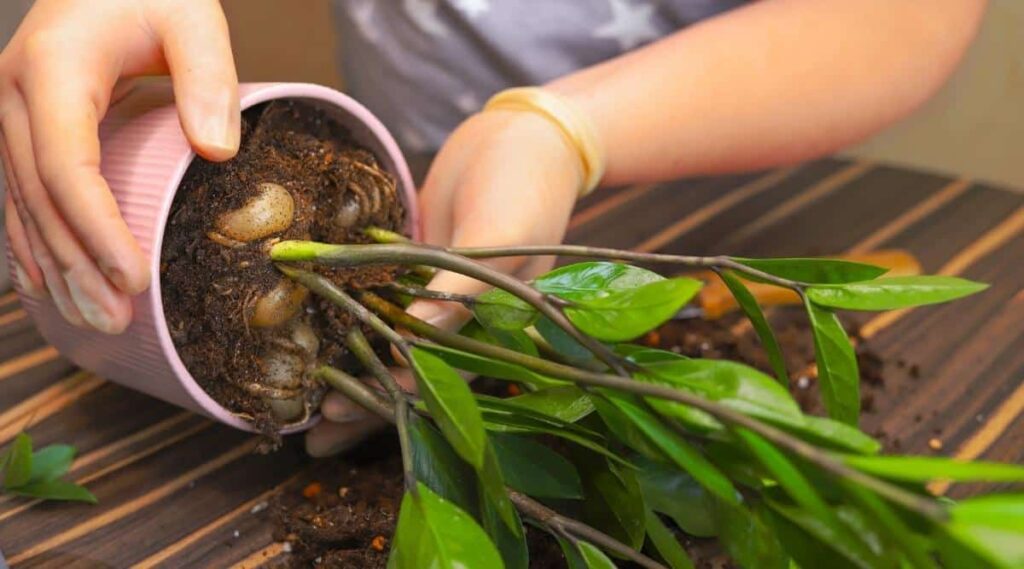

Proper drainage is a non-negotiable aspect when it comes to cultivating a thriving ZZ plant. As a native of Eastern Africa, ZZ plants have adapted to survive in arid regions with sporadic rainfall.
Consequently, these plants cannot tolerate waterlogged soil, as excess moisture can lead to root rot and other harmful conditions. To ensure a thriving ZZ plant, it’s vital to use a well-draining soil mix, which can be found at garden centers and online retailers.
This creates an environment where water can flow freely through the soil, allowing the ZZ plant to access moisture as needed without risking root damage.
Nutrient-Rich
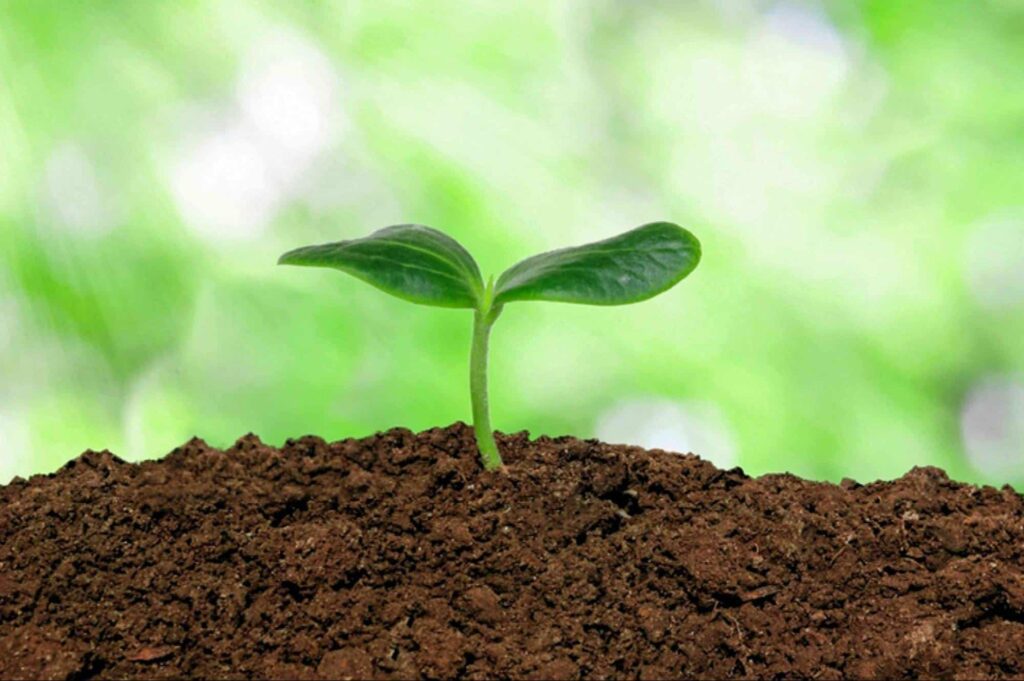

ZZ plants may appear resilient, but they require a regular supply of essential nutrients to thrive and showcase their full beauty. Proper nutrition is crucial for their growth, development, and overall well-being.
When choosing a soil mix for your ZZ plant, opt for one that offers a nutrient-rich composition with a balanced combination of minerals and trace elements.
A balanced nutrient approach is ideal for these plants. Aim for an N-P-K ratio of around 10-10-10 or 20-20-20.
- Nitrogen (N): Nitrogen is crucial for overall plant growth, including the development of leaves and stems. It plays a significant role in the synthesis of chlorophyll, which is essential for photosynthesis.
- Phosphorus (P): Phosphorus supports root development, flowering, and fruiting. It aids in energy transfer within the plant and is particularly important during periods of active growth.
- Potassium (K): Potassium contributes to overall plant health by enhancing disease resistance, water regulation, and the activation of enzymes responsible for various physiological processes.
To ensure your ZZ plant receives the best nutrition, consider using a high-quality, all-purpose indoor plant fertilizer. This type of fertilizer contains a balanced blend of these essential nutrients suitable for a wide range of indoor plants, including ZZ plants.
Follow the recommended fertilization schedule to maintain the right nutrient balance.
Aeration and Oxygenation
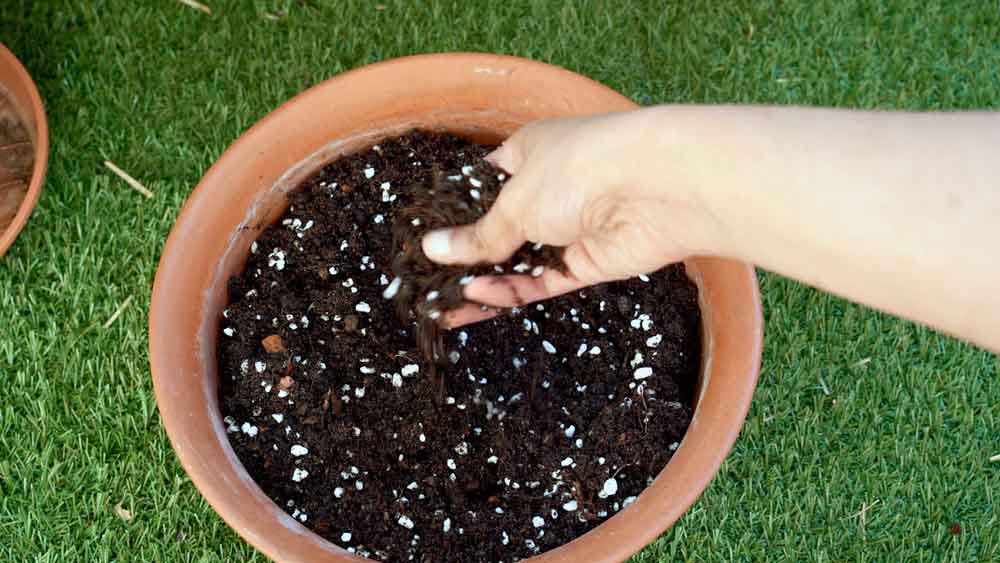

For ZZ plants to thrive, they require proper aeration and oxygenation at the root level. Just like any living organism, ZZ plants rely on oxygen to carry out essential metabolic processes crucial for their growth and overall vigor.
Ensuring a well-aerated soil environment is paramount in promoting optimal root health, as healthy roots form the backbone of a successful plant.
Incorporating porous materials into your soil mix is an effective way to enhance aeration and oxygenation. Three excellent options for promoting airflow are perlite, bark, and coconut coir.
Perlite
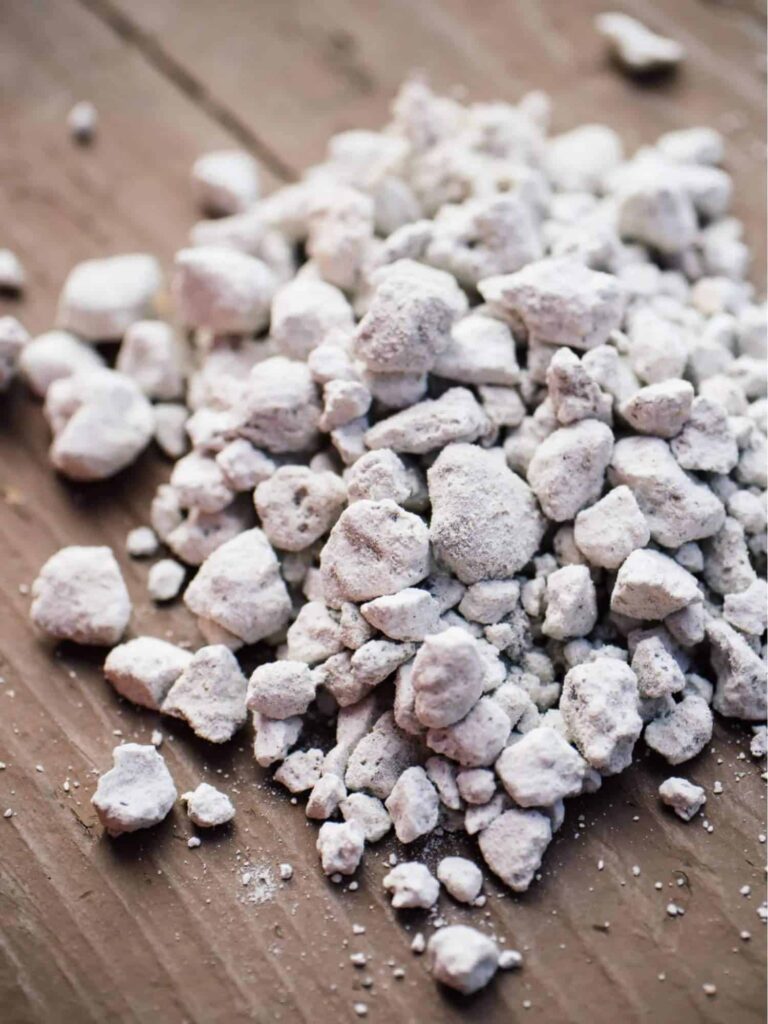

Perlite is a lightweight, porous material that creates air pockets within the soil, promoting improved aeration.
Its presence in the potting mix allows excess water to drain away while ensuring the roots have access to ample oxygen.
This prevents the soil from becoming compacted, which could hinder root growth and lead to various issues.
Bark
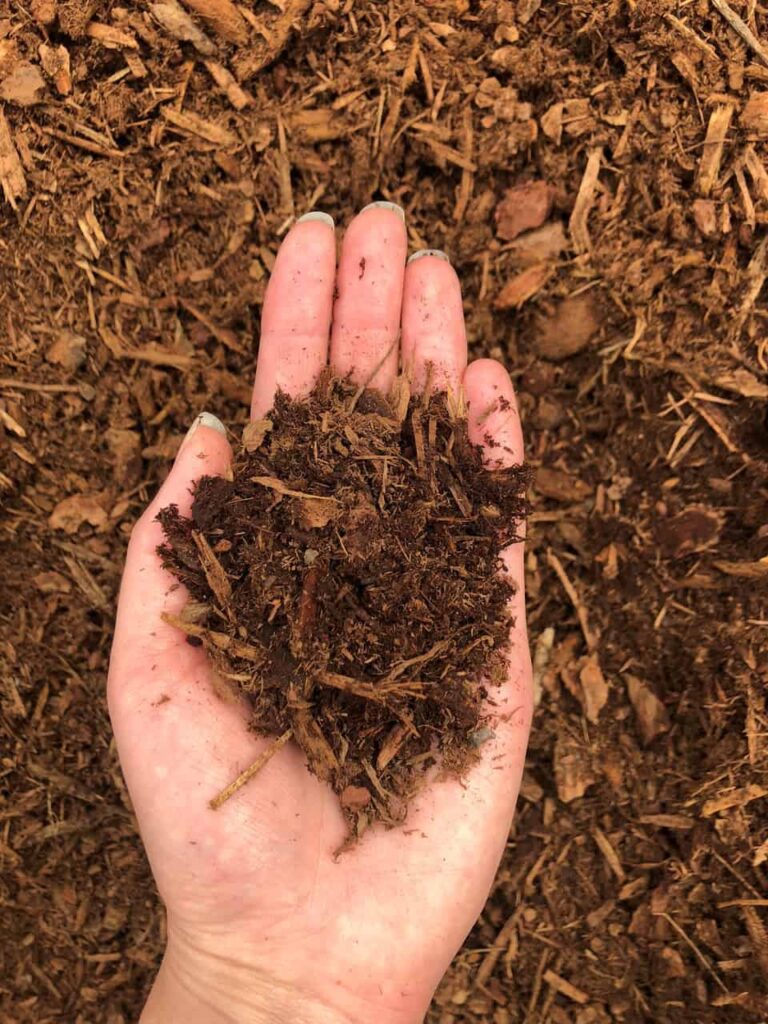

Bark particles create gaps in the soil, allowing oxygen to penetrate and reach the root system.
This not only supports root development but also helps prevent waterlogged conditions, safeguarding the plant from potential root rot.
Coconut Coir
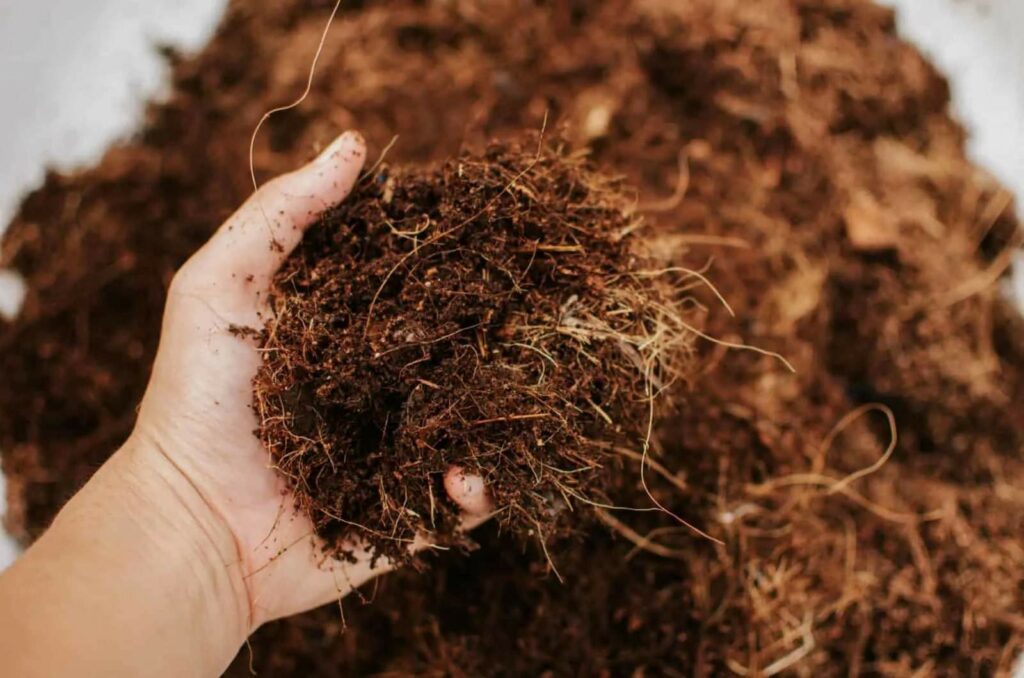

Coconut coir, derived from coconut husks, is an eco-friendly option for enhancing aeration and oxygenation in the soil.
Its fibrous structure allows for better airflow, promoting a healthy root environment.
Coconut coir also boasts excellent water retention properties, striking a balance between retaining moisture for the plant and preventing waterlogging.
Choosing the Right Potting Mix for ZZ Plants
Now that we understand the qualities to look for in the best soil for ZZ plants, let’s explore the different types of potting mixes that cater to their specific needs.
Peat-Free Potting Mix
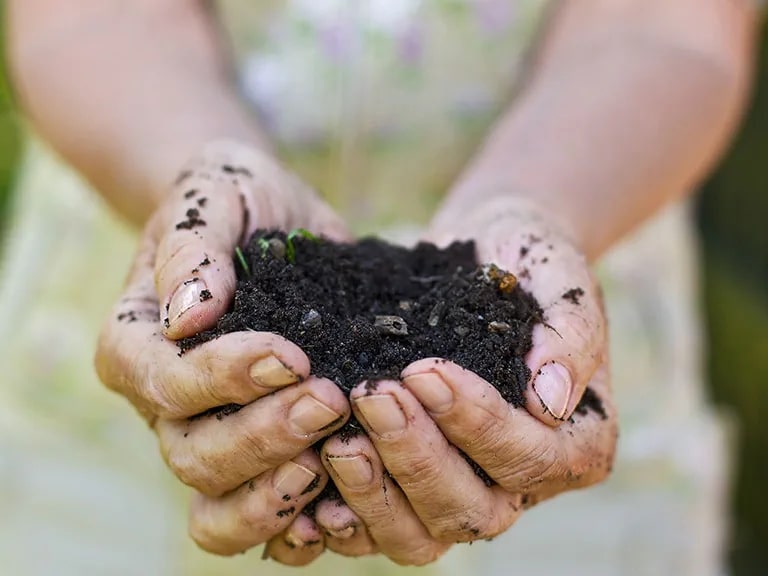

Peat-free potting mixes have emerged as a sustainable and eco-friendly alternative to traditional soil mixes, offering numerous benefits for ZZ plants and the environment.
These innovative blends provide the ideal balance of excellent drainage and moisture retention, creating a nurturing environment for the growth of healthy ZZ plant roots.
- Eco-Friendly and Sustainable: Peat-free potting mixes are crafted without the use of peat moss, which is typically sourced from delicate and ecologically sensitive peat bogs.
By opting for peat-free mixes, you actively contribute to the preservation of these valuable ecosystems, which serve as vital carbon sinks and habitats for unique plant and animal species.
- Excellent Drainage: Peat-free potting mixes are thoughtfully engineered to ensure superior drainage properties.
The inclusion of materials like coconut coir and perlite creates a porous structure within the mix, allowing excess water to escape easily.
This prevents the roots from becoming waterlogged and minimizes the risk of root rot, a common issue that can be detrimental to ZZ plant health.
- Moisture Retention: While drainage is crucial, ZZ plants still require a certain level of moisture to thrive.
Peat-free potting mixes strike the perfect balance by incorporating composted bark, which effectively retains moisture without causing waterlogging.
This moisture retention feature ensures that your ZZ plant has access to the necessary water supply during dry periods, contributing to its resilience and longevity.
- Nutrient-Rich and Well-Balanced: Peat-free potting mixes are carefully formulated to provide essential nutrients and minerals for your ZZ plant’s growth.
The combination of coconut coir, composted bark, and perlite offers a well-balanced blend that supports robust root development and overall plant health.
- pH Neutral: Peat-free potting mixes generally maintain a neutral pH, which is suitable for ZZ plants and many other houseplants.
This pH neutrality ensures that the soil mix won’t become too acidic or alkaline, maintaining a favorable environment for nutrient uptake and root health.
Perlite-Enhanced Potting Mix
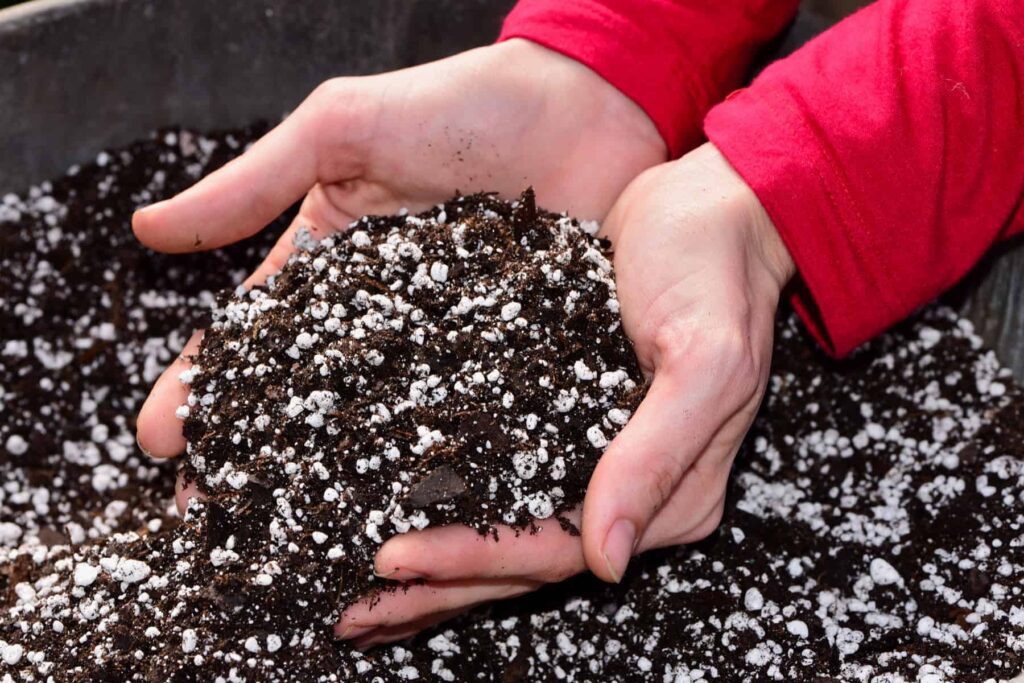

For plant parents who place a premium on providing optimal drainage and oxygenation for their ZZ plants, a perlite-enhanced potting mix is a wise and effective choice.
Perlite, a remarkable volcanic glass, plays a pivotal role in enhancing the soil’s characteristics and creating an environment conducive to the flourishing of ZZ plant roots.
- Lightweight and Porous Nature: Perlite is renowned for its lightweight and porous nature, which sets it apart from traditional soil components.
The lightweight nature of perlite prevents the potting mix from becoming excessively heavy, making it easier for you to handle and manage your ZZ plant during repotting or routine care.
This feature is especially valuable when dealing with larger or heavier planters.
- Preventing Soil Compaction: One of the most significant advantages of using perlite in the potting mix is its ability to prevent soil compaction.
Traditional soil mixes can become dense over time, reducing pore spaces and limiting airflow to the roots.
On the other hand, the addition of perlite creates air pockets within the soil, maintaining essential pore spaces and ensuring the soil remains loose and well-aerated.
- Promoting Optimal Drainage: ZZ plants thrive when the soil around their roots allows water to flow freely and doesn’t retain excess moisture.
Perlite’s porous structure enables excellent drainage, ensuring that water efficiently moves through the potting mix and away from the roots.
- Enhancing Oxygenation: Adequate oxygenation at the root level is essential for ZZ plant health. The presence of perlite in the potting mix guarantees that your ZZ plant’s roots have access to ample oxygen.
This supports robust root development, which is vital for nutrient uptake and overall plant vitality. With plentiful oxygen available, your ZZ plant can efficiently carry out essential metabolic processes, ensuring it remains healthy and vibrant.
- Compatible with Organic Materials: Perlite’s versatility makes it a valuable addition to various organic materials commonly found in potting mixes.
When combined with materials like coconut coir, compost, or peat moss, perlite creates a well-balanced and nutrient-rich environment that encourages healthy ZZ plant growth.
This compatibility allows for the creation of a customized potting mix tailored to the specific needs of your ZZ plant.
All-Purpose Indoor Potting Mix
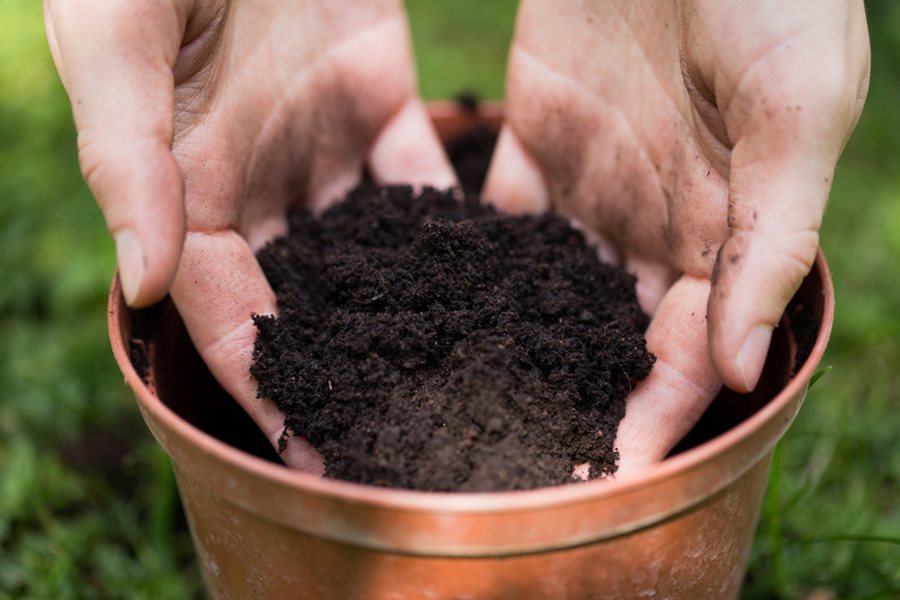

For those seeking convenience and a hassle-free gardening experience, an all-purpose indoor potting mix is a reliable and versatile option for nurturing ZZ plants.
Designed to cater to the needs of various indoor plants, including ZZ plants, these mixes offer a well-rounded approach to ensure your plant thrives in an indoor setting.
- Versatility for Indoor Plants: As the name suggests, all-purpose indoor potting mixes are formulated to accommodate a wide range of indoor plants. This makes them a convenient choice for plant parents with diverse collections.
Whether you have ZZ plants, pothos, snake plants, or other common houseplants, these mixes provide a balanced environment that suits the requirements of most indoor foliage.
- Good Drainage Properties: The best all-purpose indoor potting mixes have good drainage properties.
Adequate drainage is essential for ZZ plants to prevent waterlogged conditions that can lead to root rot and other moisture-related issues.
Look for mixes that include materials like perlite, vermiculite, or coarse sand, which contribute to effective drainage.
- Lightweight and Easy to Handle: All-purpose indoor potting mixes are typically lightweight, making them easy to handle and work with when repotting or tending to your ZZ plant.
This characteristic is especially beneficial if you have multiple indoor plants to care for or if you prefer to use larger planters.
- Nutrient-Rich Blend: These mixes often come enriched with essential nutrients, providing a solid foundation for your ZZ plant’s growth.
However, it’s essential to monitor your plant’s nutrient requirements over time, as the initial nutrients in the mix may become depleted with regular watering and plant growth.
Supplementing with fertilizers when needed will help maintain your ZZ plant’s health and vibrancy.
- Widely Available: All-purpose indoor potting mixes are widely available at garden centers, nurseries, and online retailers, making them easily accessible for most gardeners.
You can find reputable brands that prioritize quality and tailor their mixes to suit indoor plants’ specific needs.
Soil Mix Recipes for ZZ Plants
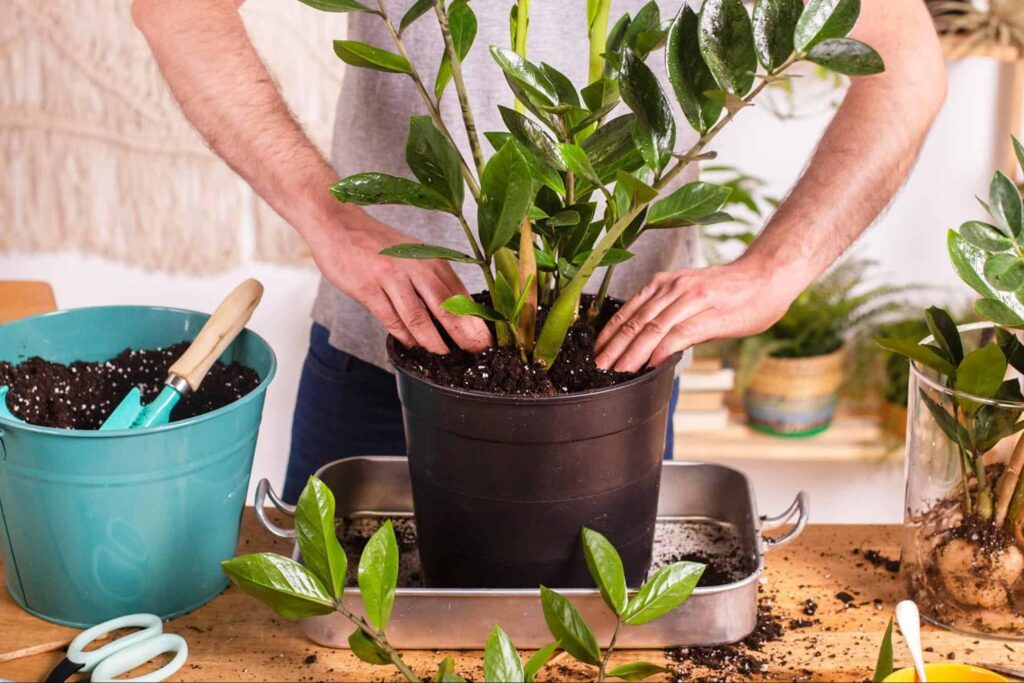

Recipe 1
- 2 parts all-purpose potting soil
- 1 part horticultural sand
- 1 part perlite or pink bark fines
This soil mix recipe is an excellent choice for ZZ plants due to its balanced composition. The all-purpose potting soil offers a solid foundation with a blend of water retention and drainage, which is crucial for ZZ plants’ health.
The inclusion of horticultural sand enhances the mix’s drainage capacity, preventing waterlogging and reducing the risk of root rot.
The addition of perlite or pink bark fines promotes effective aeration, preventing soil compaction and fostering healthy root growth.
Recipe 2
- 3 all-purpose potting soil, such as Miracle Grow
- 1 part organic material or compost
- 1 part cactus mix
The addition of organic material or compost to this recipe enriches the mix with nutrients, fostering sustained growth and vibrant foliage.
Additionally, the incorporation of cactus mix enhances the mix’s drainage further, mitigating the risks of waterlogging and root rot that ZZ plants are sensitive to.
Repotting ZZ Plants: Best Practices for Soil Replacement
ZZ plants generally prefer to be slightly root-bound, meaning they don’t require frequent repotting. However, it’s essential to recognize when it’s time to repot and how to do it correctly.
Signs that Your ZZ Plant Needs Repotting
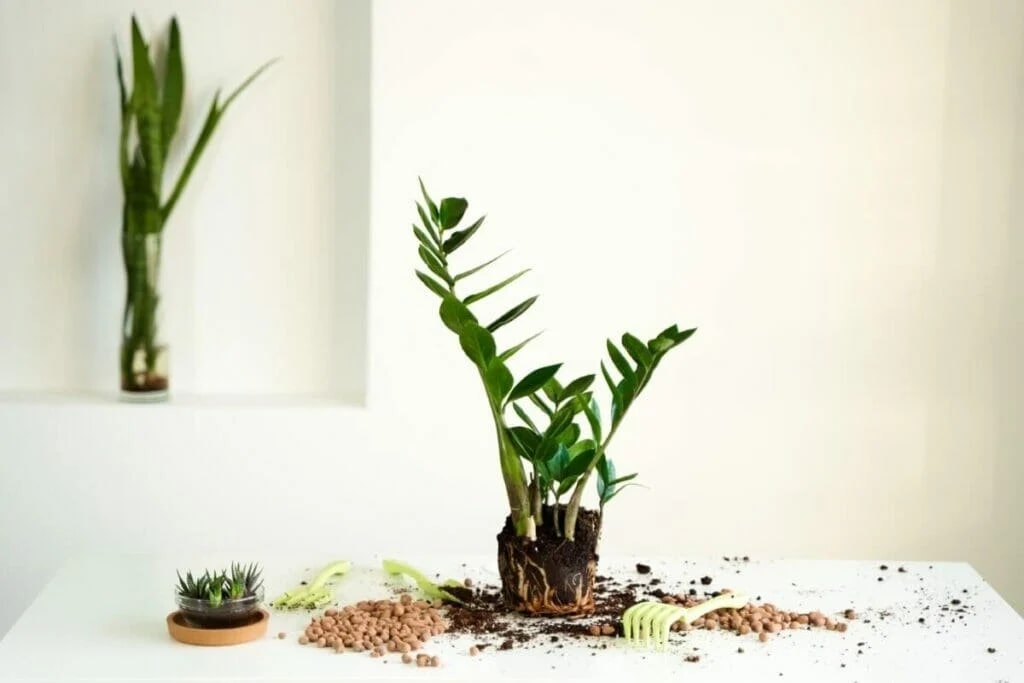

Here are some signs to watch out for, indicating that your ZZ plant might be due for a new pot and fresh soil:
- Visible Roots Escaping Through Drainage Holes: ZZ plants are relatively slow growers, but visible roots escaping through the drainage holes at the bottom of the pot indicate that the plant has outgrown its current home.
This overcrowding can lead to the roots becoming root-bound, restricting their ability to take up nutrients and water effectively. Repotting into a larger container will give the roots more space to grow and help maintain a healthy root system.
- Stunted Growth and Limited New Foliage: If you observe that your ZZ plant’s growth has slowed down, and there is limited new foliage appearing, it might be a sign that the potting mix has become depleted of nutrients.
As the plant exhausts the available resources in its current pot, it may struggle to support new growth.
Repotting into fresh, nutrient-rich soil will provide your ZZ plant with the necessary resources to rejuvenate and promote healthy foliage development.
- The Plant Becoming Top-Heavy and Prone to Tipping Over: As ZZ plants grow and develop, they can become top-heavy, causing them to tip over in their current pot.
This imbalance is not only visually unappealing but also poses a risk of potential damage to the plant.
Repotting your ZZ plant into a larger and more stable pot will help distribute its weight evenly, preventing tipping and ensuring its continued stability and well-being.
Step-by-Step Guide to Repotting
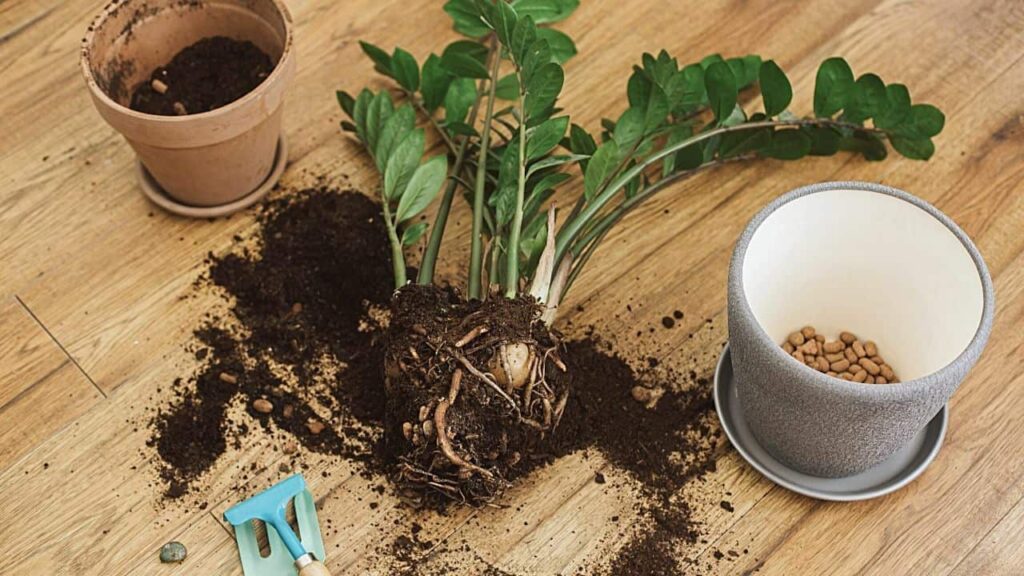

Repotting your ZZ plant is a vital task that ensures its continued health and well-being. Here’s a comprehensive step-by-step guide to help you through the process:
- Timing: Spring is the optimal time to repot ZZ plants as they transition from their dormancy phase to an active growth period.
During this time, the plant is more resilient to the disturbance caused by repotting, and its growth is robust, allowing it to adapt more easily to its new environment.
- Selecting the Pot: Choose a pot that is 1-2 inches larger in diameter than the current one. This additional space will provide ample room for your ZZ plant’s roots to grow and spread.
Avoid selecting a pot that is too large, as this may lead to excessive moisture retention around the roots, potentially causing root rot.
- Preparing the Potting Mix: Use a well-draining and nutrient-rich potting mix specifically designed for indoor plants like ZZ plants.
As mentioned earlier, a mix that includes materials like perlite, vermiculite, or coconut coir will ensure excellent drainage and sufficient nutrients for your plant’s development.
- Gently Removing the Plant: Carefully remove the ZZ plant from its current pot and be careful not to damage the roots.
If the roots have become slightly root-bound, gently loosen the root ball to encourage healthy growth in the new potting mix.
- Adding New Soil: In the new pot, place a layer of fresh potting mix at the bottom. Position the ZZ plant in the center and make sure it sits at the same planting depth as it was in the previous pot.
Fill the sides of the pot with more potting mix, gently pressing it down to secure the plant in place.
- Watering: After repotting, give your ZZ plant a light watering to settle the new soil around the roots. Be cautious not to overwater at this stage, as the plant may be adjusting to its new environment.
Avoid fertilizing for a few weeks after repotting to reduce stress on the roots, allowing the plant to acclimate and resume healthy growth.



